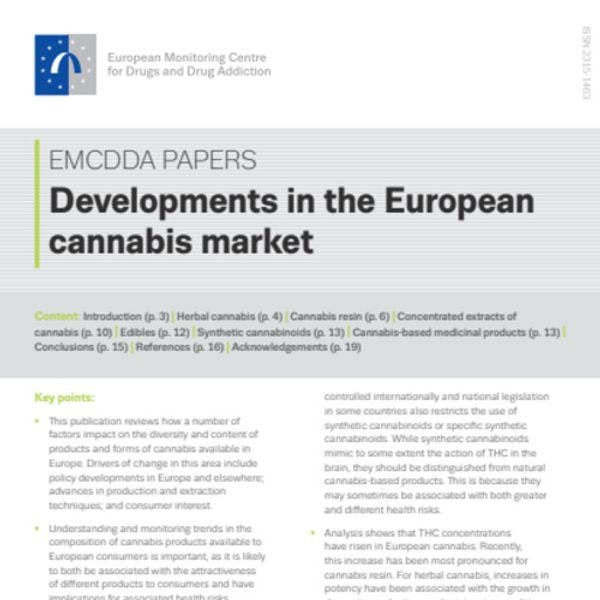Les développements au sein du marché du cannabis européen
L’OEDT examine les facteurs qui pourraient avoir un impact sur la diversité et le contenu des produits et formes de cannabis disponibles en Europe. Pour en savoir plus, en anglais, veuillez lire les informations ci-dessous.
By the EMCDDA
This paper provides an overview of established and emerging cannabis products in Europe. For each type of product, major issues in its production, distribution, use and effects on health are detailed. In doing so, the paper seeks to inform a discussion of the new challenges that may emerge in the monitoring of these products and the consequences of their use. At the time of writing, regulated markets for recreational cannabis had yet to emerge in Europe, though the policy in some countries in the Americas is rapidly shifting towards the legalisation of the recreational and medical use of cannabis. It is therefore timely to provide an overview of the diversification of cannabis products in Europe, to contribute to the available knowledge on cannabis market changes and their implications for policy and practice. While there are other aspects of relevance, including the modus operandi of organised crime groups and traffickers, prevalence and other consumption metrics, these are not addressed in this report, as detailed information is provided in other European Monitoring Centre for Drugs and Drug Addiction (EMCDDA) publications.
Cannabis is by far the most widely used illicit drug in the European Union (EU), accounting for 38 % of all money spent on the illicit drug retail market (EMCDDA and Europol, 2016). Among adults (aged 15-64), it is estimated that 24.7 million (7.4 %) have used cannabis in the last year (EMCDDA, 2019). The two main cannabis products used in Europe are herbal cannabis (marijuana) and cannabis resin (hashish). In Europe, these are typically smoked in joints (rolled cigarettes) containing tobacco (Hindocha et al., 2016).
The cannabis plant synthesises at least 144 unique compounds known as cannabinoids (Hanuš et al., 2016). The most abundant of these is ∆9-tetrahydrocannabinol (THC). THC produces the effects that people who use cannabis seek from the drug, such as feeling ‘high’ and relaxed with changes in the perception of colours and sounds. THC can also cause unwanted effects such as memory impairment, anxiety and paranoia. These adverse effects become more severe with higher doses of THC. Concentrations of THC in cannabis products have risen in recent years, and evidence suggests that users only partially adapt to changes in THC (Curran et al., 2016). As a result, people who use cannabis may have been exposed to rising doses of THC over time. These changes may have increased the level of adverse health effects related to cannabis use. In Europe, the number of first-time admissions to drug treatment for cannabis problems increased by 76 % from 2006 to 2017 (EMCDDA, 2019). It is possible therefore that an increase in the concentration of THC in cannabis is associated with this increase in admissions to treatment. These differ from synthetic forms of THC (e.g. dronabinol) and from synthetic cannabinoid receptor agonists, or ‘synthetic cannabinoids’, which are discussed later in this report. (Freeman et al., 2018). However, conclusions in this regard need to be made with caution, as other factors — such as a greater awareness of cannabis-related treatment needs, an overall increase in the level of provision and changes in referral practice, including direct referrals from the criminal justice system in some countries — could also explain this increase.
Cannabidiol (CBD) is typically the second-most abundant cannabinoid produced by/in the cannabis plant. CBD is nonintoxicating and has shown promise as a treatment for several medical conditions including epilepsy, psychosis and anxiety disorders (Bergamaschi et al., 2011; Devinsky et al., 2017; McGuire et al., 2017; EMCDDA, 2018b). CBD has been found to offset some of the harmful effects of THC, such as memory impairment and paranoia, without influencing the ‘high’ sought by users (Englund et al., 2017). Some evidence also suggests that the balance of THC to CBD may contribute to the level of harm experienced from long-term cannabis use. While frequent use of cannabis with high THC to CBD ratios has been associated with a greater risk of psychosis and dependence, it has been argued that this is less commonly observed with the use of cannabis with a more balanced THC to CBD ratio (Di Forti et al., 2015; Freeman and Winstock, 2015). It has also been suggested that encouraging the use of cannabis with a more balanced THC to CBD ratio may therefore be a strategy for harm minimisation (Englund et al., 2017).
THC and CBD are both synthesised by/in the cannabis plant in the glandular trichomes. These structures are resinous and sticky, helping to defend the plant against herbivores and environmental stresses. They differ from non-glandular trichomes, which occur in either cystolithic (found on the upper surface of the cannabis leaves) or non-cystolithic (appearing mainly on the lower side of the leaves and bracts) form. Capitate-stalked trichomes (Figure 1) are most abundantly distributed around the female flowers and produce the highest quantity of cannabinoids (Turner et al., 1978). Maximising the production of these capitate-stalked trichomes (and/ or improving the efficiency of extracting THC from them) is a key method for increasing the potency (2) of cannabis products. Bulbous trichomes are also glandular but are smaller in size and produce fewer cannabinoids. In addition to the cannabinoids, glandular trichomes also contain essential oils known as terpenes, which give cannabis its distinctive odour. Variations in the terpene profile affect the experience of using cannabis by influencing its taste and smell, and may influence its pharmacological effects (Russo, 2011).
